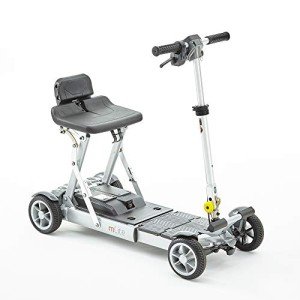Understanding Mobility Aids: Enhancing Independence and Quality of Life
As society continues to age and people progressively seek ways to keep independence, the demand for mobility aids has never been more essential. Mobility aids, which incorporate a series of devices developed to assist individuals with walking or moving, play an important function in promoting mobility, improving safety, and enhancing overall quality of life. This post will explore the different kinds of mobility aids, their advantages, factors to consider for choice, and address some often asked questions.
Kinds Of Mobility Aids
Numerous mobility aids are readily available, each designed to resolve particular requirements. angelalken.top following table sums up some of the most common types of mobility aids and their features.
| Kind Of Mobility Aid | Description | Best Suited For | Key Features |
|---|---|---|---|
| Walking canes | A portable stick offering assistance and balance. | People who require minimal help. | Light-weight, portable, adjustable height. |
| Walkers | Four-legged frames providing stability. | Those requiring substantial assistance while strolling. | Foldable, some with wheels, included security functions. |
| Rollators | Wheeled walkers with a seat for resting. | People requiring mobility with the alternative to rest. | Brakes, baskets for individual products, adjustable height. |
| Wheelchairs | Chairs with wheels for individuals with restricted mobility. | Those unable to walk or requiring comprehensive assistance. | Handbook or powered alternatives, customizable seating. |
| Scooters | Motorized devices for bigger ranges. | Individuals with restricted endurance but needing independence. | Various sizes and styles, often transportable. |
| Crutches | Support devices placed under the arms or forearms. | People recuperating from lower limb injuries. | Adjustable, lightweight, requires upper body strength. |
| Stairlifts | Mechanical devices for moving in between floors. | Users dealing with obstacles in multi-level homes. | Customizable for different staircases, automated. |
Benefits of Mobility Aids
Mobility aids provide a selection of advantages that can substantially boost the lives of individuals facing mobility difficulties. Some noteworthy advantages consist of:
- Increased Independence: Mobility aids empower individuals to move easily without counting on others for support, thereby enhancing their self-confidence and self-confidence.
- Enhanced Safety: Using mobility aids can decrease the danger of falls and injuries, specifically for older adults or those with balance issues.
- Improved Quality of Life: By facilitating mobility, people can take part in social activities, go to events, and enjoy life more totally, adding to much better psychological and psychological health.
- Rehabilitation Support: After surgery or injury, mobility aids provide needed support and stability, helping in recovery and rehab processes.
- Ease of access: Many mobility aids are created to be utilized both indoors and outdoors, ensuring that individuals can browse various environments with ease.
Aspects to Consider When Choosing Mobility Aids
Choosing the appropriate mobility aid needs mindful factor to consider of a number of aspects, consisting of:
| Factor | Factors to consider |
|---|---|
| User's Needs | Examine the level of mobility needed; think about whether the user requires short-lived or long-term support. |
| Physical Limitations | Evaluate the user's strength, balance, and coordination to figure out the best kind of help. |
| Setting | Think about the primary environments where the aid will be used, such as home, outdoors, or specific terrains. |
| Weight and Portability | Ensure that the selected gadget is manageable regarding mobility and storage, specifically for outside use. |
| Budget plan | Mobility aids can be found in a series of prices; consider insurance protection and available financing choices. |
| Adjustability | Choose aids that can be changed for height and convenience to accommodate growth or changing needs. |
Regularly Asked Questions About Mobility Aids
1. How do I understand if I require a mobility aid?
Many factors can signal the requirement for a mobility help, such as trouble walking or stabilizing, tiredness while standing, or a recent surgery impacting mobility. Consulting with a health care expert can provide guidance customized to private requirements.
2. What types of mobility aids are covered by insurance coverage?
Coverage varies between insurance companies, but many provide alternatives for resilient medical devices, which usually consists of wheelchairs, walkers, and some types of walking canes. Contact your insurance coverage supplier for particular coverage info.
3. Can mobility aids be utilized outdoors?
Yes, many contemporary mobility aids are developed for outdoor use. Rollators, scooters, and some walkers are equipped with functions for stability and ease of usage on various surface.
4. How do I maintain my mobility aid?
Regular upkeep includes checking for any wear and tear, guaranteeing that parts such as wheels, brakes, and frames are working properly, and cleaning the devices as required. Following the maker's standards is crucial for safety.
5. Exists a threat of ending up being depending on mobility aids?
While some users may become reliant on mobility aids, they are created to promote self-reliance and mobility. Slowly utilizing a mobility aid can enhance self-confidence and aid maintain physical strength and coordination.
Mobility aids are important tools that empower people to conquer physical challenges, promoting self-reliance and enhancing lifestyle. By understanding the various types of mobility aids readily available, their benefits, and important factors for consideration, families and caretakers can make educated choices that best meet the requirements of their enjoyed ones. With the best support, those with mobility difficulties can lead fulfilling and active lives, free to explore the world around them.

